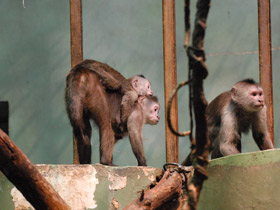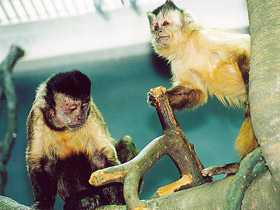The family Cebidae
The Cebidae are one of the five families of New World monkeys now recognised. Extant members are the capuchin and squirrel monkeys. These species are found throughout tropical and subtropical South and Central America.
Habitat and nutrition
Cebidae are a family of platyrrhine primates (New World monkeys), one of five currently recognised that includes the capuchin and squirrel monkeys. The family consists of 3 genera and 17 species.
Zebids are distributed in South America from Honduras in the north to southern Brazil in the south. They are found mainly in tropical and subtropical evergreen and mangrove forests, but some species have adapted to live at altitudes up to 3,000 metres and others in forests with distinctly dry seasons. Zebids spend most of their time in the canopy of tall trees, but sometimes descend to the ground in search of food or to move from one part of the forest to another. It is not for nothing that zoologists relegate these primates to the family of clawed-tailed monkeys, as with the help of their long curved tails they can cling to branches and even grasp small objects.
Zebids feed mainly on ripe fruits and insects, but can also eat unripe fruits, twigs, leaves, flowers, seeds, roots, other types of invertebrates (molluscs, spiders), bird eggs, chicks and even small mammals.
Social behaviour and reproduction
Zebids live in groups of 5 to 30 animals with one or more males. In small groups, the ratio of males to females is usually 1:1, in larger groups the females are more numerous (ratio 1:3). Despite the lack of strict territoriality, the different groups of Cebidae are often very aggressive towards each other.
The gestation period of Cebidae varies between 150 and 160 days; a single calf is usually born (twins are extremely rare). The calf spends the first three months on its mother's back, approaching her breast only to receive milk. At six months of age, it can eat "adult food", but still stays close to its mother, who protects it and feeds it with milk. At 9-12 months of age, young Zebu Cebidae begin an independent life. Puberty is slow and females usually give birth for the first time at the age of 5-6 years. For their size, Cebidae are exceptionally long-lived: in captivity they used to live up to 45 years.
Particularities
Cebidae are by far the most intelligent monkeys in the New World, and they are very intelligent. Their brains account for about 1.9% of their total weight, compared to 2% for humans and 0.9% for chimpanzees. Cebidae love hard-shelled nuts and seeds, but are unable to crack them, so they continually smash the shell of one seed against another. Scientists have recently discovered that zebids systematically use tools in the wild, such as cracking nuts by throwing stones at them, which they bring from far away and carefully store. Young monkeys cannot learn this technique the first time and must learn it from their mothers. Zebids are perfectly tame and easily master different tricks, which is why Indians often keep them as pets.
In the wild, zebids are well known for their habit of rubbing their fur with odorous substances. In the zoo, they can also be seen rubbing onions or garlic.
Classification
Previously, New World monkeys were divided between Callitrichidae and this family. For a few recent years, marmosets, tamarins, and lion tamarins were placed as a subfamily (Callitrichinae) in Cebidae, while moving other genera from Cebidae into the families Aotidae, Pitheciidae and Atelidae. The most recent classification of New World monkeys again splits the callitrichids off, leaving only the capuchins and squirrel monkeys in this family.
- Subfamily Cebinae (capuchin monkeys):
- Genus Cebus (gracile capuchin monkeys):
- Colombian white-faced capuchin or Colombian white-headed capuchin, Cebus capucinus;
- Panamanian white-faced capuchin or Panamanian white-headed capuchin, Cebus imitator;
- Marañón white-fronted capuchin, Cebus yuracus;
- Shock-headed capuchin, Cebus cuscinus;
- Spix's white-fronted capuchin, Cebus unicolor;
- Humboldt's white-fronted capuchin, Cebus albifrons;
- Guianan weeper capuchin, Cebus olivaceus;
- Chestnut capuchin, Cebus castaneus;
- Ka'apor capuchin, Cebus kaapori;
- Venezuelan brown capuchin, Cebus brunneus;
- Sierra de Perijá white-fronted capuchin, Cebus leucocephalus;
- Río Cesar white-fronted capuchin, Cebus cesare;
- Varied white-fronted capuchin, Cebus versicolor;
- Santa Marta white-fronted capuchin, Cebus malitiosus;
- Ecuadorian white-fronted capuchin, Cebus aequatorialis;
- Genus Sapajus (robust capuchin monkeys):
- Tufted capuchin, Sapajus apella;
- Blond capuchin, Sapajus flavius;
- Black-striped capuchin, Sapajus libidinosus;
- Azaras's capuchin, Sapajus cay;
- Black capuchin, Sapajus nigritus;
- Crested capuchin, Sapajus robustus;
- Golden-bellied capuchin, Sapajus xanthosternos;
- Subfamily Saimiriinae (squirrel monkeys):
- Genus Saimiri:
- Bare-eared squirrel monkey, Saimiri ustus;
- Black squirrel monkey, Saimiri vanzolinii;
- Black-capped squirrel monkey, Saimiri boliviensis;
- Central American squirrel monkey, Saimiri oerstedi;
- Guianan squirrel monkey, Saimiri sciureus;
- Humboldt's squirrel monkey, Saimiri cassiquiarensis;
- Collins' squirrel monkey, Saimiri collinsi.




















































